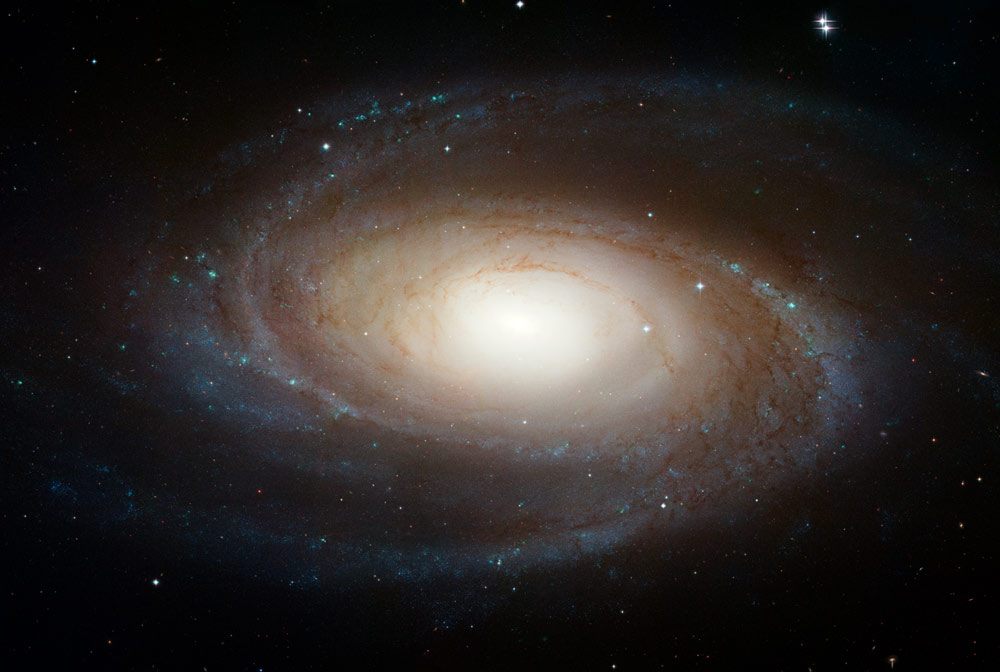
The sharpest image ever taken of the large "grand design" spiral galaxy M81 was released today at the American Astronomical Society Meeting in Honolulu, Hawaii. A spiral-shaped system of stars, dust, and gas clouds, the galaxy's arms wind all the way down into the nucleus.
This beautiful galaxy is tilted at an oblique angle on to our line of sight, giving a "birds-eye view" of the spiral structure. The galaxy is similar to our Milky Way, but our favorable view provides a better picture of the typical architecture of spiral galaxies. Though the galaxy is 11.6 million light-years away, NASA Hubble Space Telescope's view is so sharp that it can resolve individual stars, along with open star clusters, globular star clusters, and even glowing regions of fluorescent gas.
The spiral arms, which wind all the way down into the nucleus, are made up of young, bluish, hot stars formed in the past few million years. They also host a population of stars formed in an episode of star formation that started about 600 million years ago. The greenish regions are dense areas of bright star formation. The ultraviolet light from hot young stars are fluorescing the surrounding clouds of hydrogen gas. A number of sinuous dust lanes also wind all the way into the nucleus of M81.
The galaxy's central bulge contains much older, redder stars. It is significantly larger than the Milky Way's bulge. A black hole of 70 million solar masses resides at the center of M81. The black hole is about 15 times the mass of the Milky Way's black hole. Previous Hubble research shows that the size of the central black hole in a galaxy is proportional to the mass of a galaxy's bulge.
M81 may be undergoing a surge of star formation along the spiral arms due to a close encounter it may have had with its nearby spiral galaxy NGC 3077 and a nearby starburst galaxy (M82) about 300 million years ago. Astronomers plan to use the Hubble image to study the star formation history of the galaxy and how this history relates to the neutron stars and black holes seen in X-ray observations of M81 with NASA's Chandra X-ray Observatory.
M81 is one of the brightest galaxies that can be seen from the Earth. It is high in the northern sky in the circumpolar constellation Ursa Major, the Great Bear (at R.A. 9h 55m 33s, Dec. 69° 03' 55" N). At an apparent magnitude of 6.8 it is just at the limit of naked-eye visibility. The galaxy's angular size (19') is near that of the Full Moon.
The Hubble data was taken with the Advanced Camera for Surveys in 2004 through 2006. This color composite was assembled from images taken in blue, visible, and infrared light.
Release Date: 3:30PM (EDT) May 28, 2007
Release Number: STScI-2007-19
For additional information, contact:
Ray Villard,
Space Telescope Science Institute, Baltimore, Md.,
(phone) 410-338-4514,
(e-mail) villard@stsci.edu
Andreas Zezas,
Harvard-Smithsonian Center for Astrophysics, Cambridge, Mass.,
(phone) 617-496-7637, (e-mail) azezas@cfa.harvard.edu
Keith Noll,
Space Telescope Science Institute, Baltimore, Md.
(phone) 410-338-1828, (e-mail) noll@stsci.edu
Credit for Hubble Image:
NASA,
ESA,
and The Hubble Heritage Team
(STScI/AURA).
The original version of this work, with more images and videos, is available at the
STScI WWW server.
Updated: June 10 '07
Best seen with MS Internet Explorer.
Back: Gallery: Hubble Photographs Grand Design Spiral Galaxy M81
Messages: